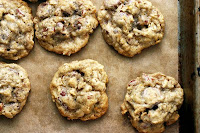
Beans are rich in essential vitamins and minerals, fiber, and when paired with rice or another whole grain, they are considered a complete protein. They are great finger foods by themselves and also make delicious meals.
I prefer to buy them dry and then soak them overnight. This eliminates exposure to Aluminum and the harmful chemical, BPA, from the can. After soaking, boil them for approx. 30 minutes until they are tender. This is true for all beans except for lentils and split peas. These beans do NOT require soaking- bonus for when you are in a time crunch or just forgot to soak 'em.
Here are some of Cece's (and mine!) favorite bean recipes. You can double any of these recipes and freeze them for later.
LentilsSweet Potato and Coconut DahlIngredients:
-1 lb. sweet potatoes, cut into 1/2 inch cubes (I leave the skins on for added fiber)
-1 cup dry lentils
-1 14 oz. can coconut milk
-2 cups water
-1 tsp grated fresh ginger root
-1 tsp. ground cinnamon
-1 tsp. tumeric
-salt and pepper
1. Put the sweet potatoes into a saucepan with the lentils, coconut milk, and water. Bring to a boil, then leave to cook gently, uncovered, for 15-20 minutes, until the sweet potato is tender and the mixture looks thick.
2. Stir in the ginger, cinnamon, tumeric, and salt and pepper. Then cook gently for a few more minutes to blend in the flavors. Can serve by itself or over rice.
*Note that the spices are added after the lentils are tender- if you add them at the beginning, they can prevent the lentils from becoming tender!
Adzuki BeansThese beans are popular in Japan and are revered as being one of the healthiest beans. They are an excellent source of magnesium, iron, zinc, and copper. Adzuki beans also contain protease inhibitors which frustrate the development of cancerous cells. They look like little black beans. You can buy them in bulk at most grocery stores.
Adzuki Bean CasseroleIngredients:
-1 c Dried adzuki beans
-1 tbsp Olive oil
-1 md Onion; chopped
-2 Granny Smith Apples; cored
and chopped (not peeled)
-1 md Green bell pepper; seeded &
chopped
-1 Bay leaf
-1/4 tsp basil
-1/4 tsp Sea salt
-1/2 tsp Tamari Soy sauce (or soy sauce)
1. Soak dried adzuki beans in 3 cups cold water for 24 hours OR, in an
emergency, use 3 cups boiled water for at least 2 hours.
2. Drain beans completely and boil for 45 minutes in 2 cups fresh water
or until tender.
3. Saute chopped onion in 1 tbsp olive oil 1 minute. Add bell pepper,
saute 1 minute. Add apple and saute until onions are translucent.
Drain beans and mix in vegetables. Season with basil, sea salt and
soy sauce. Oil a small casserole dish and pour in mixture. Embed bay
leaf into top of beans and bake at 375.
Garbanzos (or chickpeas)Chickpea and Squash Casserole*Remember to soak the chickpeas overnight and boil until tender.
Ingredients:
-2 cups fresh cooked chickpeas (or 1 can chickpeas)
-1.5 cans unsweetened coconut milk
-1/2 cup brown basmati rice
-1 cup water (to cook brown rice in)
-2 tbsps olive oil
-2 cloves garlic
-1 tbsp curry powder (or tumeric)
-1 tsp dry mustard
-1 tsp ground cumin
-1 tsp ground coriander
-1 tbsp fresh grated ginger
-1 tsp salt
-1 butternut squash, peeled and diced
-1 tart apple, diced
-1/2 cup fresh parsley
1. Preheat oven to 350 F. Lightly oil 2.5 qt casserole dish.
2. Bring 1 cup water to a boil. Add 1/2 cup rice. Let simmer for 40 minutes until soft.
2. Mix chickpeas and coconut milk in a casserole dish. Set aside.
3. Heat olive oil over med heat, add onion and garlic. Add curry powder, mustard, cumin, coriander, ginger, and salt. Saute 3-5 mins until onion is softened.
4. Transfer onion mixture to casserole and add the squash, apple, cooked rice and parsley. Stir to blend well.
5. Bake for 1 hr or until the squash and apple are tender (make take longer than 1 hr).


















